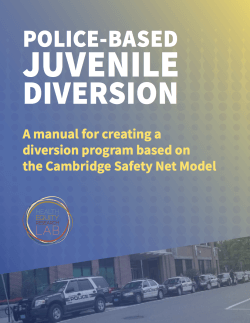New Manual Helps Municipalities Create Diversion Programs to Help At-Risk Youth

The Cambridge Safety Net Collaborative is an innovative partnership between Cambridge Health Alliance (CHA), the Cambridge Police Department, Cambridge Public Schools and the Cambridge Department of Human Service Programs.
It fosters positive youth development, promotes mental health, supports safe school and community environments and limits youth involvement in the juvenile justice system through coordinated prevention, intervention and diversion services for Cambridge youth and families.
The Collaborative identifies at-risk youth and, through an integrated process incorporating insight and recommendations from CHA and Cambridge’s school, police, and human services departments, determines the best intervention, such as a mentoring opportunity, afterschool program or mental health support. Since its inception in 2007, the Collaborative has assisted hundreds of families in the Cambridge community.
Based on this nationally renowned model, the City of Cambridge and the CHA Health Equity Research Lab have teamed to publish a new resource that is intended to help police departments and municipalities all over the country implement pre-complaint juvenile diversion programs. Designed to help serve as a turnkey for police departments and municipalities, the comprehensive “Police-Based Juvenile Diversion” manual provides an overview of the Safety Net Program, guidance on establishing critical partnerships, the key steps to delivering a structured case management process and tools to help evaluate the effectiveness of such a diversion program. Also included are sample key documents, including letters, draft agreements and youth service plans to help expedite the implementation of similar programs for other police departments and municipalities.
“Cambridge Safety Net is a model for how police, schools and clinical supports can collaborate to help keep young people safe and healthy,” said James Barrett, PhD, clinical director of the Safety Net Collaborative and a member of CHA’s Department of Psychiatry. “Our hope is that this manual can help other cities to develop diversion programming to keep youth out of detention and help link them to services.”
Recent reports from Citizens for Juvenile Justice and the National Council for Behavioral Health have recognized the Safety Net model as a best practice for juvenile diversion. Research studies have demonstrated that Safety Net has had a significant impact on juvenile arrests (according to a 2016 study, community arrests have decreased more than 50 percent since its implementation), recidivism and service utilization (contracting with mental health services has led to an average of 94 outpatient mental health provider referrals per year).
“In interviews with families, participating officers and community leaders, there has been positive feedback about Safety Net as a program that reduces arrests and links youth to the services they need instead of disruptive and potentially traumatizing correctional services,” said Benjamin Lê Cook, PhD, MPH, director of CHA’s Health Equity Research Lab. “Our analysis of extensive health and arrest data backs this up, showing that Safety Net reduces arrests, recidivism and increases access to mental health care.”
Now, more than ever, mechanisms that bridge the gap between the police and the community are critical to social justice and equity. Download the “Police-Based Juvenile Diversion” manual here.